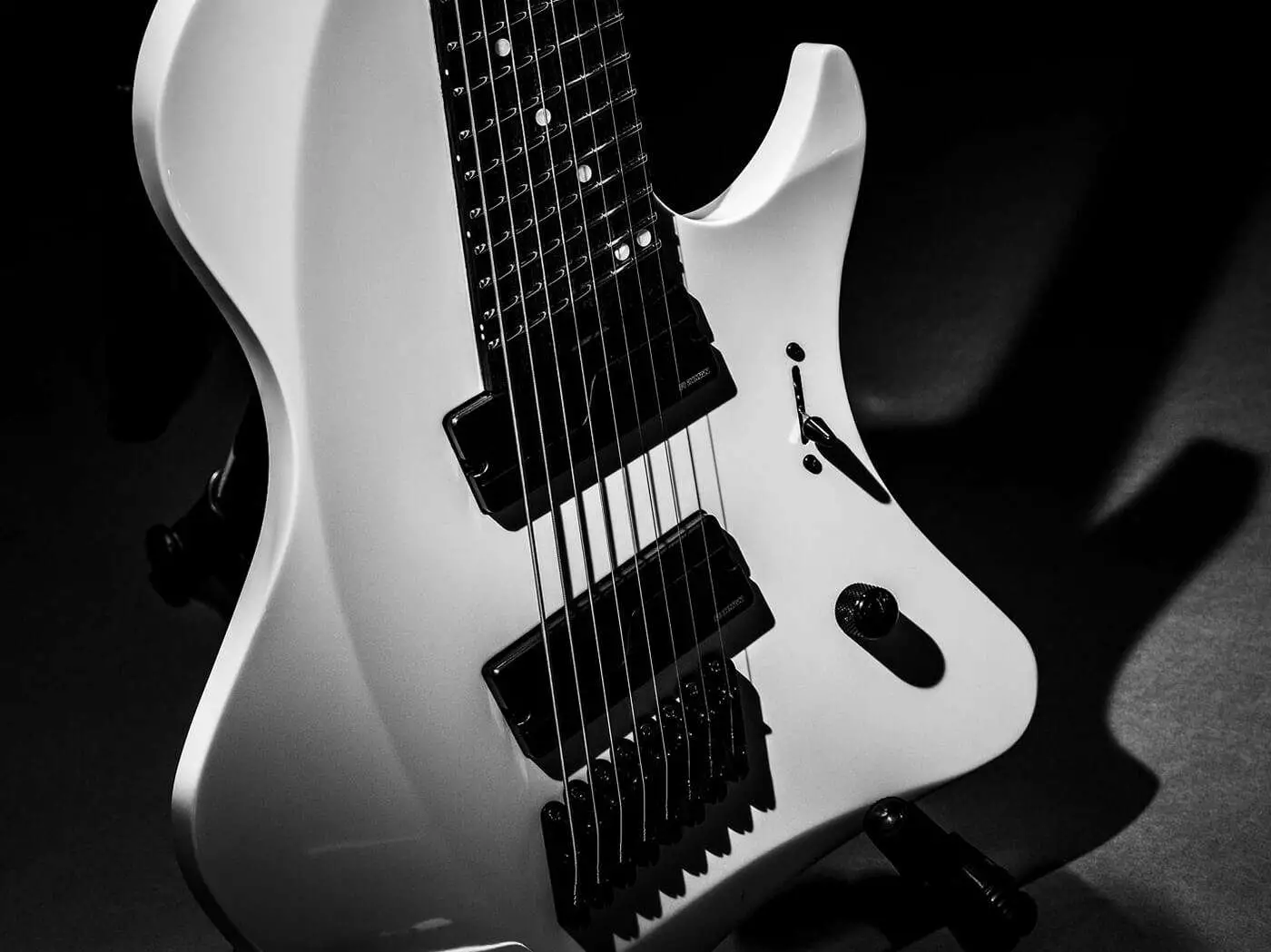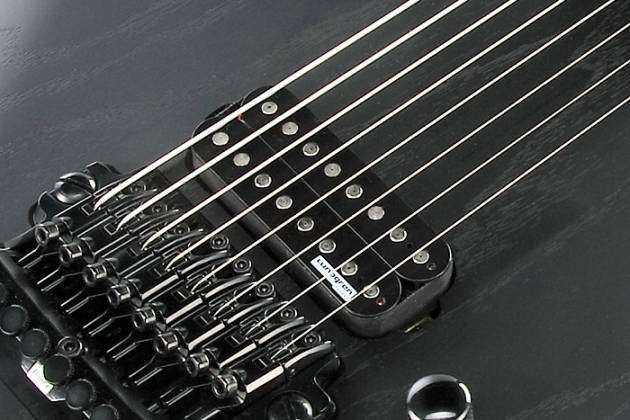As with many things, tuning an 8 string guitar may seem daunting at first, but with the right knowledge, it’s a straightforward process that opens up a world of sonic possibilities.
Standard 8 string tuning typically involves the notes F#-B-E-A-D-G-B-E, adding a lower F# and a B below the standard 6-string guitar tuning.
Whether you’re aiming to churn out heavy metal grooves or intricate jazz solos, mastering your tuning is key to nailing those perfect tones. In this guide, we’ll cover all you need to know about getting your 8-string guitar in tune, ensuring each note rings true & every chord resonates just as you intend. Strap in, and let’s get those strings sounding sharp!
Related: How to tune a 7-string guitar

Related: How To Tune a 9 String Guitar
8 String Guitar Tuning Basics
Tuning an 8 string guitar involves a meticulous approach to ensure each string resonates at its intended pitch. The standard tuning adds two lower strings to the traditional six-string setup, resulting in the notes F# and B below the standard E. To accurately tune your guitar, you’ll need a reliable tuner like the one below and a steady hand. Follow these steps for a precise tuning:
- Begin with the 8th string, tuning it down to F#.
- Move up to the 7th string, tuning it to B.
- Tune the 6th string to E, following the standard guitar tuning.
- Set the 5th string to A.
- Adjust the 4th string to D.
- Tune the 3rd string to G.
- Calibrate the 2nd string to B.
- Finally, tune the 1st string to E.
It’s essential to frequently check and retune as necessary since the added tension from the lower strings can cause slight shifts in tuning across the guitar.
8 String Guitar Tuner:
Common Tunings For 8 String Guitar
Below is a table of common tunings for 8 string guitar, including the renowned “Galbraith Tuning,” which uniquely expands the guitar’s range by adding one string above and one string below the standard 6-string tuning.
| Tuning | Description | Notes |
|---|---|---|
| Standard | Adds two lower strings to the traditional six-string setup | F#-B-E-A-D-G-B-E |
| Galbraith | Adds one string below and one above the standard tuning, offering a classical guitar feel | A-D-G-C-E-A-D-F# |
| Drop E | Similar to standard tuning but with the lowest string dropped to E for heavier riffs | E-B-E-A-D-G-B-E |
| Open E | An open tuning that creates an E major chord when strummed open | E-B-E-G#-B-E-Ab-B |
| New Standard | Created by Robert Fripp for a versatile range | C-G-D-A-E-G-C-D |
Drop Tuning An 8 String Guitar (Drop E)
Common Drop Tunings For 8 String Guitar
Dropped tunings on an 8-string guitar provide a heavier sound and facilitate power chords with a single finger, making them a favorite among metal and hard rock players.
Here’s a table showcasing some common dropped tunings for 8-string guitars, which typically involve lowering the pitch of the lowest string for easier access to drop power chords.
| Tuning | Description | Notes |
|---|---|---|
| Drop E | The 8th string is dropped a whole step from standard tuning for a heavier edge | E-B-E-A-D-G-B-E |
| Drop A | The 7th and 8th strings are dropped for a deep, aggressive tone | E-A-E-A-D-G-B-E |
| Drop F# | A further step down from Drop E, giving an even lower range | F#-B-F#-B-E-G#-C#-F# |
| Drop G | A variant that offers a balance between depth and playability | G-C-G-C-F-A-D-G |
| Galbraith Drop A | A variation of Galbraith Tuning with the 8th string dropped to A | A-D-G-C-E-A-D-E |
| Double Drop E | Both the 7th and 8th strings are dropped to E for extended power chord options | E-E-A-D-G-B-E-A |
These dropped tunings enhance the guitar’s ability to produce thick, resonant chugs and are especially useful for creating a massive sound in metal genres. Experiment with each to see how they can transform your playing style and musical creations.
The Benefits of Various 8 String Tunings
As you dive into the various 8 string tunings, you’ll discover a treasure trove of sonic capabilities that can enhance your music, regardless of genre or playing style. Your standard tuning of F#-B-E-A-D-G-B-E extends your tonal range, giving you the power to produce deep, resonant bass notes while retaining the familiar feel of a 6-string guitar in the higher pitches.
If you’re a metal enthusiast, tuning down to E-B-E-A-D-G-B-E can give your riffs a heavier edge with an even lower sonic reach. For those of you with a passion for jazz or progressive music, open tunings can simplify the creation of complex chords, fostering a seamless flow of innovation.
Alternate tunings are a gateway to fresh songwriting ideas & techniques, offering you a means to carve out a distinct sound, whether you’re crafting a djent masterpiece or weaving through sophisticated jazz progressions.
| 8 String Tunings | Genre | Benefits |
|---|---|---|
| F#-B-E-A-D-G-B-E | Any | Expansive range with a touch of familiarity |
| E-B-E-A-D-G-B-E | Metal | A heavier, more menacing sound |
| A-E-A-D-G-B-E-A | Progressive | Ethereal textures and complex harmonies |
| F#-B-E-A-D-F#-B-E | Jazz | Effortless chord transitions and rich variety |
| B-E-A-D-G-B-E-A | Experimental | Unconventional voicings and an extended sonic canvas |
This table acts as a personalized guide, quickly showing you the benefits of exploring different ways of tuning an 8 string guitar, and how they can be applied to your musical endeavors, ensuring that your instrument is as versatile and expressive as your imagination allows.

Related: How to tune a 12-string guitar
Tips for Maintaining Stable Tuning on an 8-String Guitar
Tuning an 8 string guitar and retaining stability requires a bit more finesse due to the extended range and increased string tension. Ensuring your instrument stays in tune not only improves your playing experience but also keeps your performances sounding professional.
Start with a well-constructed guitar that can handle the tension, and use appropriate gauge strings to support the lower tunings. Regularly check and tighten the hardware, such as the tuning pegs and bridge, as they can loosen over time.
Additionally, stretching your strings properly when you first install them will help prevent tuning drift. Lubricating the nut and saddle can also reduce friction, allowing the strings to glide smoothly and maintain pitch.
Here’s a quick list of tips to keep your 8-string guitar reliably in tune:
| Tip | Description |
|---|---|
| Proper String Gauge | Use heavier strings for lower tunings to maintain tension and tuning stability. |
| Stretch Strings | Stretch new strings adequately to help them settle and hold pitch better. |
| Tighten Hardware | Regularly check and tighten machine heads and bridge components to prevent slippage. |
| Nut and Saddle Lubrication | Apply a small amount of lubricant to the nut and saddle to ease string movement and prevent binding. |
| Stable Environment | Keep the guitar in a stable temperature and humidity to avoid wood and string contraction/expansion. |
| Quality Tuners | For lower-end instruments, consider investing in quality locking tuners for improved tuning stability. |
| Regular Tuning Checks | Frequently re-tune during playing sessions, as the low strings can detune more quickly. |
By following these tips, you’ll minimize the hassle of constant retuning and enjoy a more consistent sound from your 8-string guitar.

Frequently Asked Questions
What Tuning Does Meshuggah Use?
Meshuggah is known for using a unique and innovative tuning system that they developed themselves, called “Djent tuning.” This tuning is characterized by its extended range and the use of eight strings on the guitar. In their earlier days, they relied more on 7 string guitars since 8 string instruments weren’t as readily available. They would then commonly tune to Bb (Bb Eb Ab Db Gb Bb Eb), which is a half step down from standard tuning for 7 string guitars.
When the band moved to 8-string guitars, it made sense for them to begin performing in the same tuning but with an extra F on the lowest string:
F, Bb, Eb, Ab, Db, Gb, Bb, Eb
This tuning allows for a wide range of powerful low, and it’s ideal for Meshuggah’s distinctive rhythm guitar style, which features complex polyrhythms and syncopated grooves. It’s also a popular tuning for many other progressive metal and djent bands, as it provides a lot of flexibility and versatility for the guitarist.
How Are 7 & 8 String Guitars Tuned?
Because seven and eight-string guitars have more strings that allow for a broader range of notes and lower tunings, they are often tuned differently than ordinary six-string guitars. The following are some popular tunings for seven and eight-string guitars:
7-String Guitar Tunings:
Standard 7-String Tuning: B E A D G B E
Drop A Tuning: A E A D G B E
Drop G Tuning: G C F Bb Eb G Bb
8-String Guitar Tunings:
Standard 8-String Tuning: F# B E A D G B E
Drop E Tuning: E B E A D G B E
Drop C# Tuning: C# G# C# F# A# D# G# C#
Related: Standard Tuning In Guitar: How To Do It & What You Need To Know (6 string) 
What Frequency Should I Tuned My 8 String Guitar To?
For standard tuning on an 8-string guitar, you should tune the lowest string to F#1, which is approximately 23.12 Hz, and the highest string to E4, around 329.63 Hz.
Always use the A440 Hz standard as a reference pitch for tuning the A string, ensuring that your guitar harmonizes correctly with other instruments.
Who Plays 8 String Guitars?
Here are 10 guitarists who are known for playing 8-string guitars:
- Tosin Abasi (Animals as Leaders)
- Meshuggah (Fredrik Thordendal and Mårten Hagström)
- Javier Reyes (Animals as Leaders)
- Misha Mansoor (Periphery)
- Charlie Hunter
- Aaron Marshall (Intervals)
- Stephan Forté (Adagio)
- Ron “Bumblefoot” Thal
- Mark Holcomb (Periphery)
- Josh Travis (Emmure, Glass Cloud)
These are just a handful of the many outstanding musicians that play the 8-string guitar. Each of these guitarists has a distinct playing style and approach, and they have contributed to broaden the possibilities of what may be accomplished on an extended range guitar.
How Many Octaves Does An 8 String Guitar Have?
An 8-string guitar, often referred to as an “extended range guitar” (ERG), typically spans a range of about 3.5 to 4 octaves, with standard tuning stretching from F#1 to E5.
The instrument’s range can vary with different tunings or scale lengths. While there are specialized variants like the Fanned Fret or Baritone 8-string, they all fall under the broad category of 8-string guitars, offering a wider sonic palette than the traditional 6-string.

How Does String Gauge Affect Tuning Stability on an 8-String Guitar?
String gauge plays a crucial role in the tuning stability of an 8-string guitar. Heavier gauges provide more tension, which is essential for maintaining pitch on the lower strings that are tuned to lower notes. Conversely, lighter strings may detune more easily, especially when subjected to heavy playing or bending, making them less stable for extended range instruments.
